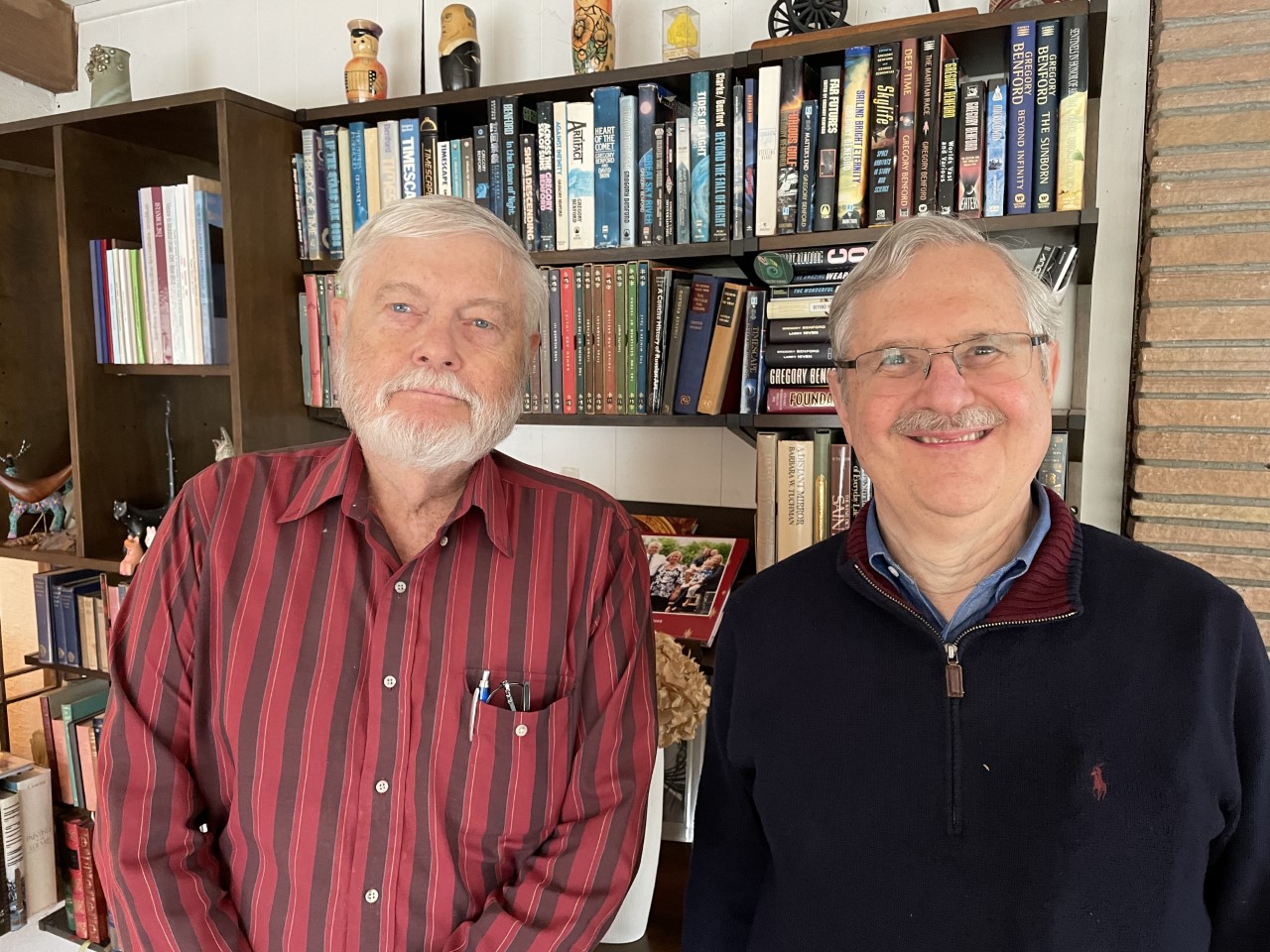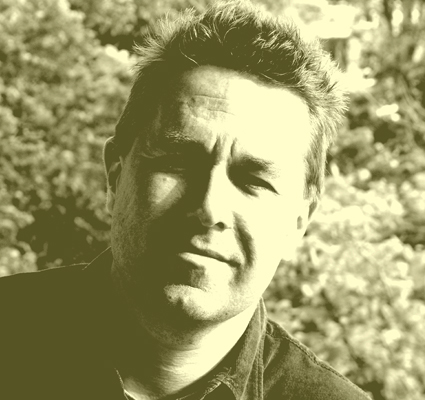Astronomers Who Write Informed Science Fiction: A Novel Way to Do Astronomy Education
Andrew Fraknoi Fromm Inst./U of San Francisco
Many an astronomer today will tell interviewers that their early interest in science was piqued by reading or watching science fiction. For example, Carl Sagan wrote an eloquent piece (Sagan 1979) on how science fiction affected him when he was young, and what particular stories had significant influence.
But astronomers are now turning things the other way round, by having some influence on the course of modern science fiction. A number of professional astronomers and physicists have been writing intriguing science fiction that, as you might expect, tends to extrapolate from (and often explain) some of the latest ideas in known science. Some have become leaders in the literary area called “hard science fiction” — stories based mainly on the hard facts of nature that do not involve fantasy, magical, or impossible elements.
The 21st century is not the first time that astronomers have written science fiction. Many historians classify Kepler as the first astronomer to do so, but his Somnium (https://somniumproject.wordpress.com/) — featuring witches and demons — is more of a fantasy. So, the honor might better be awarded to Simon Newcomb, whose 1900 novel His Wisdom the Defender (https://archive.org/details/hiswisdomdefende00newcrich/mode/2up) features a scientist who makes a world-changing discovery. Several astronomers wrote sci-fi during the 20th century, perhaps best known among them Britain’s iconoclastic Fred Hoyle, whose novels and TV programs ranged over many topics drawn from astronomy and astrobiology (including his proposal in the 1957 novel The Black Cloud that organic molecules in interstellar clouds may become organized enough to assume intelligence).
Carl Sagan’s best-selling novel Contact (1985, Simon & Schuster) tried to portray a SETI discovery in realistic terms with plausible science. Even when he decided that his protagonist eventually must travel among the stars, Sagan famously called Kip Thorne at Caltech and asked him and his students to devise a “plausible subway system” through the galaxy, within the bounds of general relativity.
But today more than ever before, people with advanced degrees in astronomy or related physics are writing (and changing) science fiction. I have compiled a table (below) of all the active science fiction writers I am aware of who are practicing astronomers. I am tickled to be able to include myself in the list these days; I have had five stories published since I began writing seriously in 2017 (Fraknoi 2022). I welcome additions to the list (please note that self-published authors are not included). In this short introduction, I can only mention a few people, but I encourage you to explore all the folks who are listed.
Gregory Benford (University of California, Irvine) is often acknowledged to be the “Dean” of “hard science fiction” writers who are scientists; he is a plasma physicist who has written papers about processes in astronomical objects. His Galactic Center series of novels gives a remarkable picture of how machine and organic lifeforms may deal with the complex region near the supermassive black hole at the center of the Milky Way (Benford 1977–1996).
His award-winning early novel Timescape (1980, Pocket Books) takes place at the University of California, San Diego, where Benford got his advanced degrees and has thinly disguised versions of well-known astronomers woven into the plot. In recent stories, he has been taking new looks at how SETI projects might be done in the future. See, for example, his recent Shadows of Eternity (2021, Saga Press).
Alastair Reynolds, who retired from the European Space Agency when his writing career became successful, is another author whose sweeping imagination is coupled with a firm regard for science. His stories have a film-noir sensibility that can often leave you with a bitter understanding of humanity’s insignificance in an uncaring cosmos.
Perhaps his most important work is a series of novels and stories that begin with Revelation Space (2000, Ace Books). The series gives us a marvelously complex universe where humanity exists in a number of genetically modified variants, and intelligent species have to contend with ancient machines that deem organic life too war-like to be permitted to exist.
If you only read one work by any of the authors I recommend here, let it be Reynolds’s "Beyond the Aquila Rift," a 2005 short story available in many collections. Few stories I have read manage to convey the true sense of distances in the universe more powerfully than this one (see Reynolds 2006).



Another imaginative writer I recommend to students is NASA scientist Geoff Landis. In his story “A Walk in the Sun,” an astronaut stranded on the Moon in a solar-powered suit must continue walking to keep up with the Sun. It’s a great lesson on how there is no permanent “dark side” of the Moon. It can be read free on the web at: https://www.baen.com/Chapters/0671878522/0671878522___1.htm.
Michael Brotherton (University of Wyoming) is another astronomer who has been having success as a science fiction writer. His two novels, Star Dragon (2003, Tor Books) and Spider Star (2008, Tor Books), are chock full of astronomical concepts and encounters with objects you regularly find in the Astrophysical Journal. In 2009, he put together Diamonds in the Sky, an anthology of astronomical science fiction by a number of authors, which is available free at: http://www.mikebrotherton.com/diamonds/.
At a time in our culture when we are turning away from science toward fantasy, magic, and “alternate facts,” some of these stories, which stick to reasonable science and technology and investigate how human beings interact with them, are a welcome antidote.
In my classes, I would often recommend a science fiction story with good science at the end of a unit, encouraging students to read for pleasure — and to read something coherent, cohesive, and meaningful, instead of short “tweets” about nothing. In my honors class, where a paper was required, one possible topic was doing a cogent analysis of the astronomy in a published story (see Fraknoi 2009). To help my students, I developed a detailed subject index to science fiction with good astronomy in it. You can find it at: http://bit.ly/astroscifi. Perhaps one of the stories I list will start one of your students on a lifetime of science-fiction enjoyment.
Living Astronomers Who Write Science Fiction
|
Gregory Benford |
University of California, Irvine |
Prolific author; Dean of hard sci-fi writers |
|
David Brin |
PhD in space science |
Writes novels, stories, essays |
|
Michael Brotherton |
University of Wyoming |
Novels and anthologies |
|
Jeanne Cavelos |
Studied astronomy @ Cornell |
Writes softer science fiction, horror |
|
Donald Clayton |
Clemson University |
Wrote one novel |
|
David L. Clements |
Imperial College, London |
Writes short stories |
|
David DeGraff |
Alfred University |
Writes short stories |
|
Andrew Fraknoi |
Foothill College, emeritus |
Writes short stories |
|
Carl Frederick |
works doing AI software now |
Writes short stories |
|
Kevin Grazier |
formerly at JPL |
Writes screenplays, advises TV shows on science |
|
John Gribbin |
full-time British science writer |
Wrote several novels |
|
William Hartmann |
Planetary Science Institute |
Novel and short stories; also an astronomical artist |
|
Steve B. Howell |
NASA Ames Res. Ctr. |
Short story, Kepler anthology |
|
Lucy Kissick |
Oxford U |
Novel about Pluto |
|
Geoffrey Landis |
NASA Lewis Res. Ctr. |
Writes novels and stories |
|
Sarah Nickerson |
NASA Ames Res. Ctr. |
Writes short stories |
|
Kaitlin Rasmussen |
U of Washington |
Writes short stories under the pseudonym C.M. Fields |
|
Alastair Reynolds |
previously at ESA |
Writes many imaginative novels and stories |
|
William Rossow |
NASA Goddard Institute |
Writes novels |
|
Robert Scherrer |
Vanderbilt University |
Writes short stories |
|
Michael Shara |
Amer. Museum of Nat. History |
Short stories with Jack McDevitt |
|
Alan Smale |
NASA Goddard Res. Ctr. |
Writes mostly alternative history |
|
Diane Turnshek |
Carnegie Mellon |
Writes short stories |
|
J. Craig Wheeler |
University of Texas |
Wrote a novel and stories |
Table Notes:
-
Plus physicists Doug Beason, John Cramer, Paul Davies, Stanley Schmidt, Vandana Singh, and Ken Wharton
-
See any author’s full range of work at the Internet Speculative Fiction Database: http://www.isfdb.org/
References:
Reynolds, Alastair, 2006, Zima Blue and Other Stories. NightShade Books. This is one of many collections that includes “Beyond the Aquila Rift.”
Fraknoi, Andrew, 2009, "Teaching Astronomy with Science Fiction," in Astronomy Education Review: http://dx.doi.org/10.3847/AER2002009
Fraknoi, Andrew, 2022, to read my published science fiction, you can go to: https://www.fraknoi.com/science-fiction-with-good-astronomy/.
Sagan, Carl, 1979, “Science Fiction: A Personal View,” collected in Broca’s Brain. (Random House)
Benford, Gregory, Galactic Center series, starts with In the Oceans of Night (1977, Dial Press) and ends with Sailing Bright Eternity (1996, Bantam).

